Protein intake is a crucial piece of the body composition puzzle. But how much protein should you eat? In this article, we’re looking at the latest research to help you better set protein targets, whether you want to lose fat or build muscle.
Unless you’ve been living under a rock your entire life and only now stumbled on this article, you’re probably aware of the importance of protein intake for optimising body composition. But just in case, here’s a quick refresher:
- When combined with resistance training, it can help support muscle growth in a calorie surplus and mitigate muscle loss in a calorie deficit.
- Increases satiety. 1
- Higher protein intake might lead to less stress and fatigue and increased diet satisfaction. 2
- Some research suggests higher protein intakes are linked to smaller waistlines, lower BMI and body weight. 3
Yet, despite the well-established benefits of protein, I speak to people all the time who aren’t eating anywhere near enough. This is especially problematic if you’re actively pursuing a body composition goal.
Case in point: A 2020 meta-analysis found protein intakes greater than the RDA (~1.3g/kg or ~0.6g/lb vs 0.8g/kg or 0.3g/lb) helped preserve muscle mass during weight loss and promoted muscle growth when participants were resistance training. However, there were no significant differences in lean mass changes when comparing higher protein intake to the RDA when there was no energy restriction or resistance training. 4
Why is this the case?
Muscle growth is dictated by the balance between muscle protein synthesis (the creation of muscle proteins) and muscle protein breakdown (the breakdown of muscle proteins).
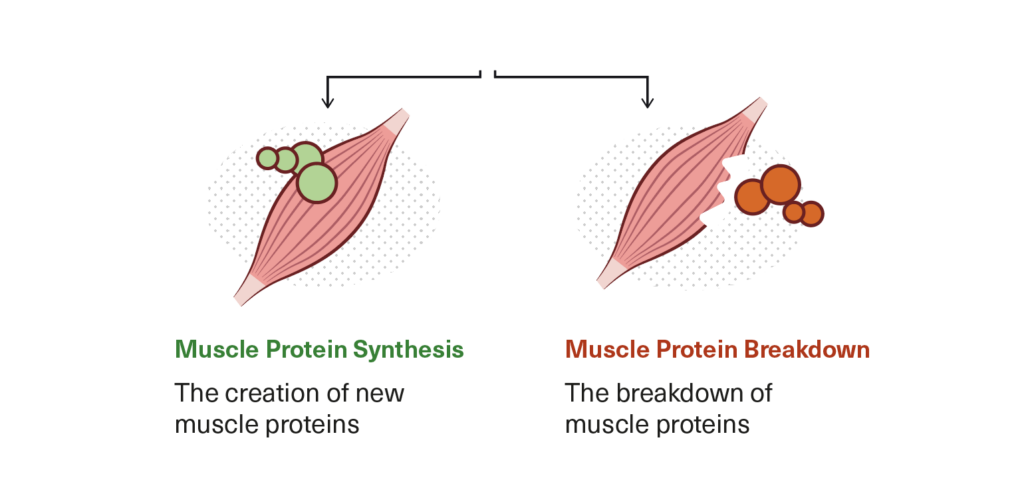
By consuming enough protein (in combination with resistance training), you keep your body in a state of positive muscle balance, where MPS outpaces MPB. Done consistently over time, you create an anabolic environment conducive to muscle growth.
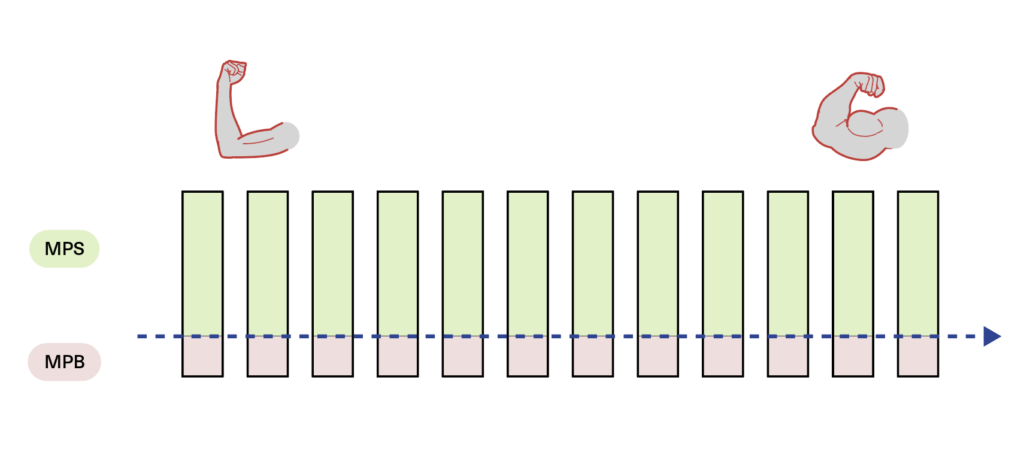
So how much protein should you eat?
A 2018 meta-analysis investigated the effects of protein supplementation on muscle and strength outcomes and concluded that about ~1.6 g/kg (~0.7 g/lb) was sufficient to maximise muscle gains, with no benefits seen beyond this amount. 5 This paper has become the de facto reference for protein intake since its publication.
But it’s not that clear-cut.
If you take a look at the image below, you’ll notice the actual range (blue line) or, more accurately, the 95% confidence interval, was quite large (1.03-2.2 g/kg/d or ~0.5-1 g/lb/d) and 1.6 g/kg was the best estimate of what the true value might be based on all the studies reviewed. As with any estimate, however, there’s an inherent level of error. Even with a cursory glance at the image, you can see some groups in the included studies (represented by the red dots) were eating below 1.6 g/kg but gained as much muscle as groups eating more protein.
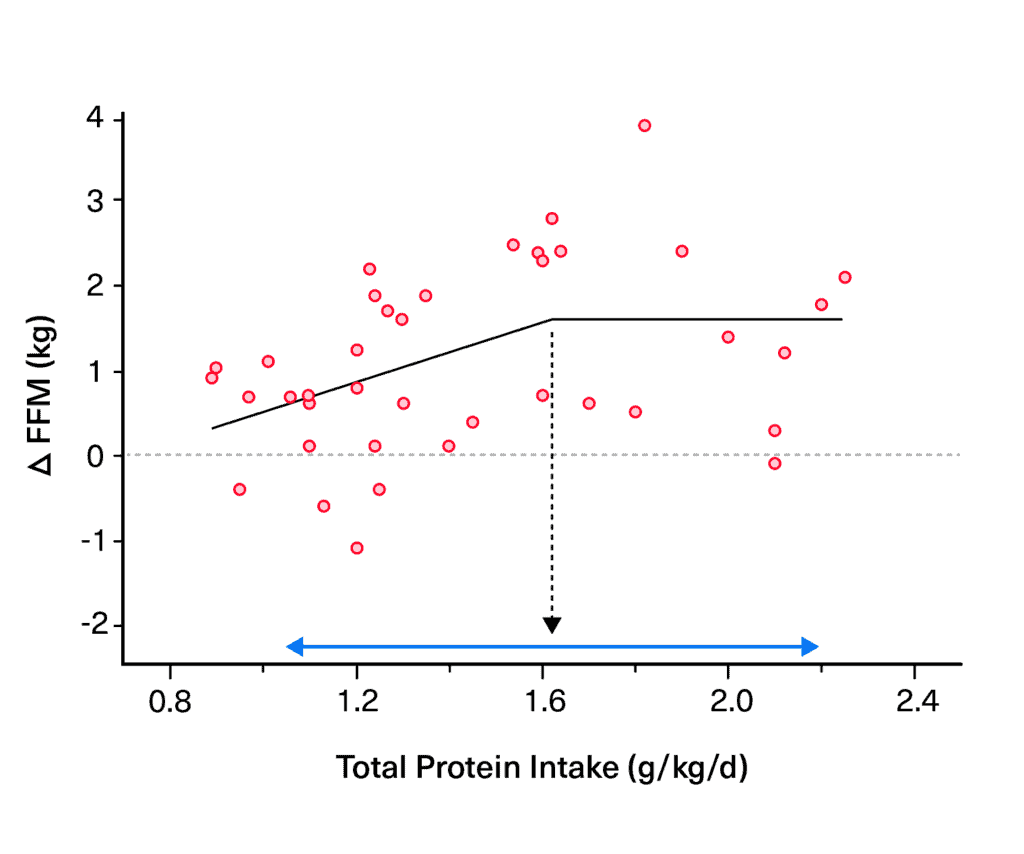
Additionally, Nunes and colleagues recently published a meta-analysis to determine if increasing protein intake contributed to gaining muscle mass. 6
The researchers grouped protein intake into three categories:
- Less than 1.2 g/kg/d
- Between 1.2-1.59 g/kg/d
- 1.6 g/kg/d or higher
They then examined how big an effect each of these protein intakes had on muscle growth. The researchers quantified the effect sizes as small (0.2-0.5), medium (0.5-0.8), and large (>0.8).
Here’s what they found:
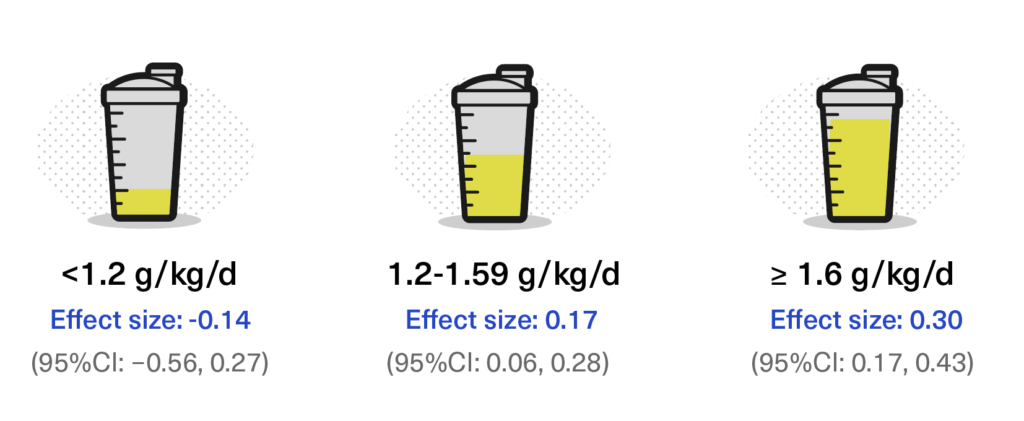
So, eating less than 1.2 g/kg/d of protein had no effect on muscle growth. Increasing protein intake to 1.2-1.59 g/kg/d had a trivial effect. And bumping up to 1.6 g/kg or higher had a small effect. In other words, increasing protein intake does lead to more muscle growth, but you’re looking at a marginal benefit when going from 1.2-1.59 g/kg/d to ≥1.6 g/kg/d. To make these numbers more tangible – increasing protein intake from the middle range (1.20 – 1.59 g/kg/day) to the higher range (≥ 1.60 g/kg/day) might lead to an additional ~0.1–0.2 kg (0.2-0.4 lbs) of muscle.
Given the findings of these two meta-analyses, anywhere between 1.2–2.2 g/kg (~0.5–1 g/lb) of protein is likely sufficient to support muscle growth (when combined with resistance training).
Aiming for around 1.6-2.2 g/kg (~0.7-1 g/lb) is probably a good idea if you want to cover all your bases and ensure you’re maximising muscle growth. You’ll still gain muscle if you go toward the lower end (1.2 g/kg), but it might not be as optimal.
But what’s optimal on paper may not be optimal for you as an individual.
Maybe you’re a recreational lifter who isn’t bothered about maximising every ounce of muscle, and maybe you struggle to meet the commonly recommended protein intake, which causes undue stress because you constantly worry about losing progress. Would it be unreasonable to lower your protein intake slightly so you can better adhere to your nutrition plan? Absolutely not.
I mention this because people tend to fall into weird camps when it comes to protein intake. If you go under some magical protein threshold, you’ll lose all your gains, turn into a big gelatinous ball of adipose, and, I dunno, explode or something. On the other hand, if you eat more protein than what’s currently recommended, you’re labelled a big dummy who follows ‘bro-science’.
In reality, neither of these is true. You have a lot of flexibility to adjust your protein intake based on your own preferences, goals, what you can adhere to, and what’s compatible with your lifestyle.
Oh, and this is a good time to mention this: Strength training alone is inherently anabolic.
You can eat all the protein you want, but without the stimulus of resistance training, you aren’t going to build (or retain) muscle. Someone following an intelligent training program and training hard will build more muscle than someone half-assing their training, even if the former is eating slightly less protein.
Now, there’s one big caveat: The studies referenced so far have looked at the association between protein intake and muscle growth while participants were in maintenance.
When you’re consuming enough calories––as is the case when eating at maintenance or a surplus––you could get away with a lower protein intake without risking muscle loss since the body has ample calories from food to use for growth and repair. However, your protein needs will likely be higher when you’re in an energy deficit.
Protein intake during a deficit
Earlier, I mentioned the importance of maintaining positive protein balance––where muscle protein synthesis outpaces muscle protein breakdown. Well, a calorie deficit decreases muscle protein synthesis and increases muscle protein breakdown, increasing the risk of muscle loss. 7
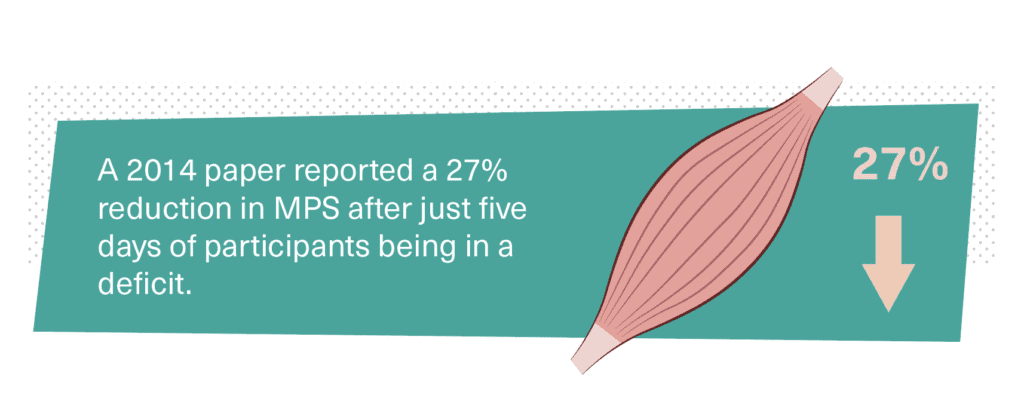
Additionally, the leaner you get, the higher the risk that muscle tissue will be broken down for fuel as the body runs low on stored glycogen and body fat.
So how much protein should you eat in a deficit?
A 2018 review paper examined protein requirements during weight loss in elite athletes, focusing on body composition and performance. The recommendation was anywhere between 1.6–2.4g/kg (~0.7-1 g/lb) of protein would be sufficient for preserving muscle mass during energy restriction, with protein intake scaling up or down depending on the size of the deficit and body fat%. 8
More recently, Refalo and colleagues published a systematic review with meta-regression looking at the effects of dietary protein on fat-free mass during a calorie deficit in resistance-trained individuals. They found the largest benefit occurred when protein intake was set to 1.9g/kg (0.9g/lb) or 2.5g/kg/FFM (~1g/lb/FFM). While there were benefits to going as high as 3.2g/kg (1.4g/lb), the effect size was small, suggesting diminishing returns. 9
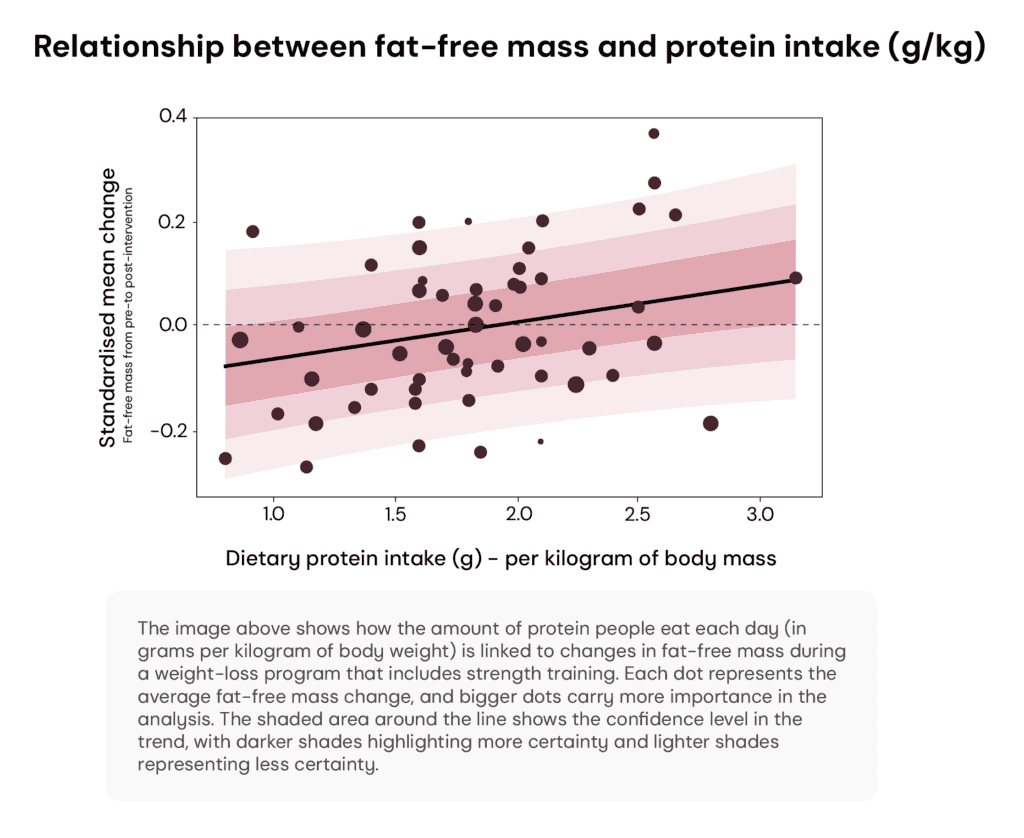
If you’re carrying a lot of body fat and decide to diet aggressively, you likely don’t need to increase protein intake to the higher end because body fat has a muscle-sparing effect (the body isn’t going to break down muscle if it has ample body fat to use for fuel). Though, of course, protein has benefits beyond supporting muscle retention, so there’s nothing wrong with higher intakes if that’s what you prefer.
On the other hand, you might have been dieting slowly for a few months and are approaching low body fat levels. In this case, increasing your protein intake isn’t a bad idea to give yourself the best chance of maximising muscle retention.
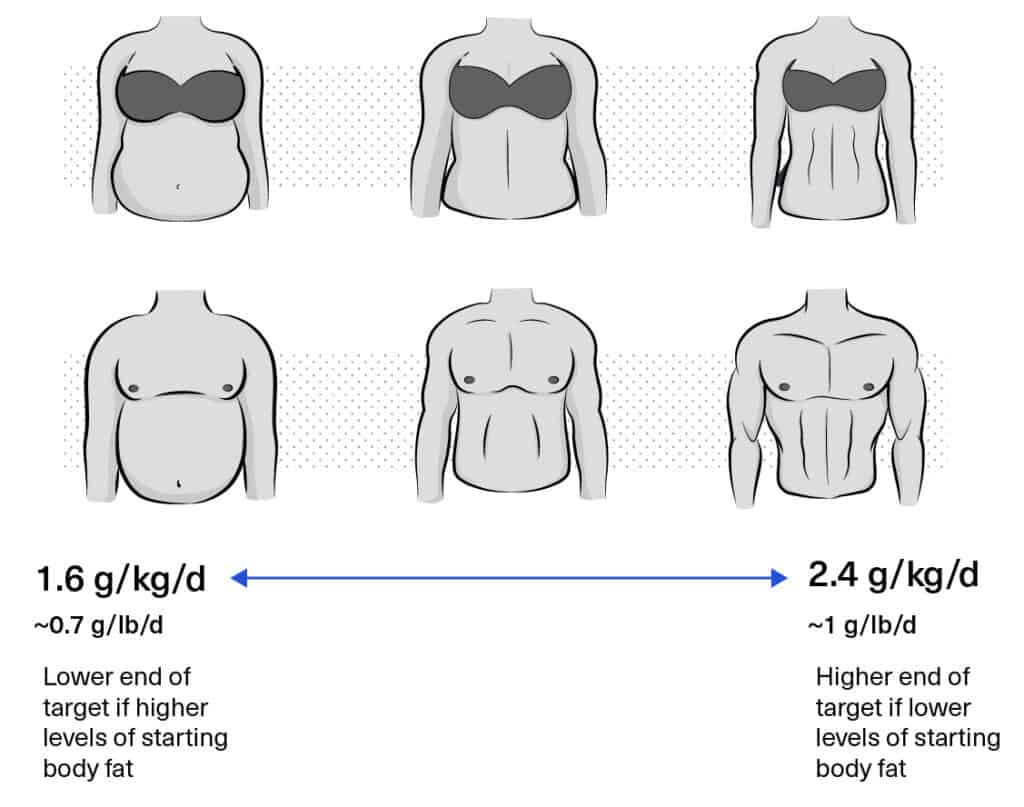
You’ll note the 1.6 g/kg (~0.7 g/lb) value crops up in both recommendations (maintenance/surplus or a deficit). And I think that’s a reasonable starting point for most people, with the option of protein intake being scaled up or down from there, depending on your preferences and goals.
Do vegans need more protein?
Compared with animal proteins, plant proteins are lower in one or two essential amino acids (EAAs; the amino acids responsible for driving muscle protein synthesis). The body can’t produce EAAs, so you need to get them through food. 10
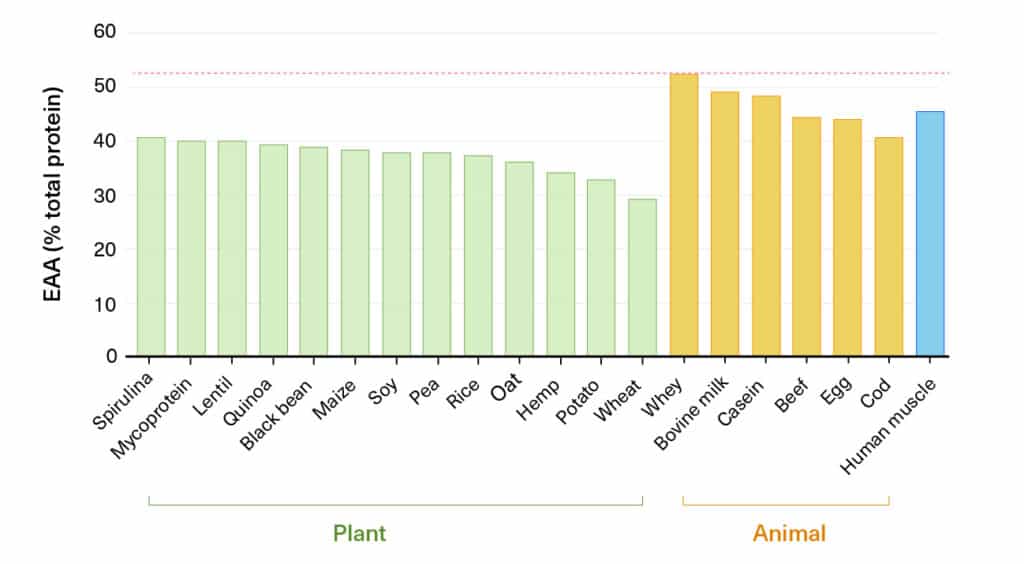
However, this isn’t a major concern as long as you’re eating enough protein every day and ensuring you’re eating a wide range of foods to make up for the limiting amino acids in individual plant foods. 11 12
For example, rice contains lower amounts of lysine but high amounts of methionine. Beans and lentils contain high amounts of lysine but low amounts of methionine. Combining rice with beans gives you a meal with a ‘complete’ EAA profile.
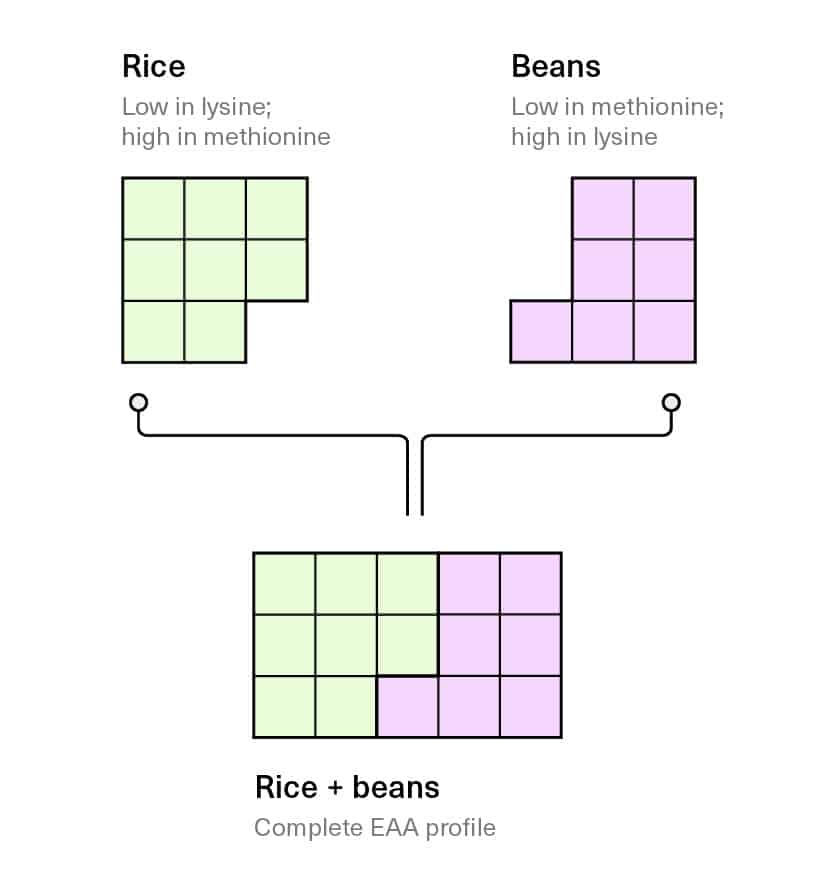
One of the challenges you might run into when following a strict vegan diet, or one where animal protein is greatly restricted, is meeting your daily protein targets through whole foods alone since plant foods are generally higher in carbs and fats.
In a deficit, where calories are low, this could lead to undereating protein to avoid exceeding your daily calorie requirements or exceeding your calorie targets to ensure you’re eating enough protein. Conversely, if you’re trying to gain muscle, the higher fiber content of plant foods can increase satiety, making it harder to eat enough to meet the surplus.
An easy way to overcome these issues is to supplement with a high-quality plant-based protein supplement, like a pea and rice protein blend that matches the amino acid profile of whey.
For example, a recent study found no difference in muscle and strength gains between habitual vegans and omnivores consuming a high-protein diet (~1.6 g/kg/d). However, the vegan group had to supplement with ~60g of soy protein to meet their daily protein targets. 13
How to set protein intake
I’ve used “per lb” or “per kg” throughout this article when referencing protein intakes.
While this is a good rule of thumb most of the time for most people, it can lead to unnecessarily high protein intakes if someone has a lot of fat to lose. If you weigh 250 lbs with 40% body fat, you don’t need to eat 170+ grams of protein.
A better approach, and the approach I use with coaching clients, is to set protein intake using lean body mass.
Ultimately, we only need to account for muscle mass while ignoring everything else that makes up body weight (water, fat, glycogen, gut content, etc.). So setting protein intake using your lean body mass provides a far more reasonable protein target.
How to use this approach
- Estimate your current body fat % (you can use the sheet linked below).
- Multiply your estimated body fat % by your total body weight to get your fat mass.
- Subtract your fat mass by your body weight to get your lean mass.
- Multiply your lean mass by your chosen protein intake. With clients, this could be anywhere between 0.8–1.2 g/lb/LM or 1.8–2.6 g/kg/LM, depending on their goals and personal preferences, but 1 g/lb or 1 g/kg per lean mass is a good in-between for those of you who are having a mini breakdown right now trying to decide where in that range you should target.
- Voila. You now have your target protein intake.
You can use this sheet to help with the calculations. Click the blue ‘make a copy’ button when prompted.
To illustrate just how much of a difference this approach can make, let’s use the example of the 250 lb person with 40% body fat.
At 1 g/lb of total body weight, they would need to eat 250g of protein. Unless you enjoy deep-throating chicken breast all day, that’s a lot of fucking protein. But if we set their protein intake to 1 g/lb of lean mass, that’s a daily protein intake of 150g––way more reasonable.
In sum
There was a lot to discuss here, especially considering that, on the surface, this is a fairly simple topic (“just eat 1 g/lb”, right?). But I wanted to discuss some nuances that tend to get left out when people talk about protein intake.
You likely don’t need to eat as much protein as you think. And you could get away with a considerably lower amount of protein and still make progress. Like most things in nutrition, there’s no one-size-fits-all approach, and you should consider your own needs, goals, preferences, what you can stick to, and what’s compatible with your lifestyle when considering protein intake.
To wrap up, here’s a summary of the key points:
- Protein is a crucial part of the body composition puzzle. Alongside resistance training, it can help preserve muscle mass when eating in a calorie deficit and support muscle growth when eating in a calorie surplus.
- If you want to lose fat or build muscle, you’ll need more protein than the current RDA.
- Anywhere between 1.2–2.2 g/kg (~0.5-1 g/lb) is likely sufficient to support muscle growth when combined with resistance training. However, 1.6-2.2 g/kg (~0.7-1 g/lb) is a ‘better safe than sorry’ target, and most people would benefit from setting their protein intake somewhere in this range.
- Protein intake should scale with body fat %. If you’re starting a cut and are relatively lean, err towards the higher end (2.2 g/kg or 1 g/lb); if you’re carrying more body fat, you can opt for the lower end (1.6 g/kg or ~0.7 g/lb). On the other hand, when you’re eating at maintenance or a surplus, lowering protein slightly won’t impact muscle growth as the body has enough calories from food to use for growth and repair.
- If you’re following a strict vegan diet or one where animal protein is greatly restricted, the first order of priority is ensuring you’re eating enough protein every day. After that, look to get some variety in the foods you’re eating to make up for the limiting amino acid profile in individual plant foods.
- The common approach is to set protein intake based on total body weight. But this can overshoot protein needs if you have a lot of fat to lose. A better approach is to set protein intake based on your lean mass.
Thanks for reading. If you enjoyed this, you’d love the Vitamin
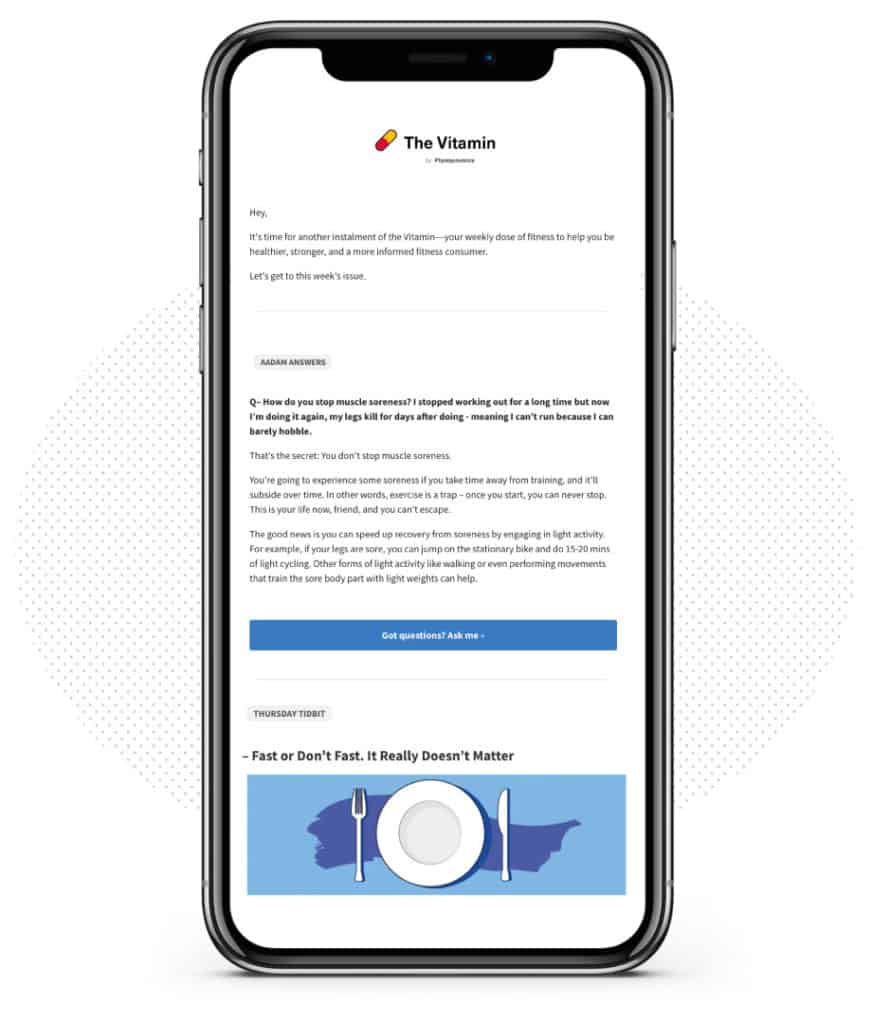
95% of my new content is only sent to my email list. One email every Thursday, filled with actionable, evidence-based fitness advice to help you with your goals. If you enjoyed this article, you’d love my emails. You can learn more and subscribe for free here.